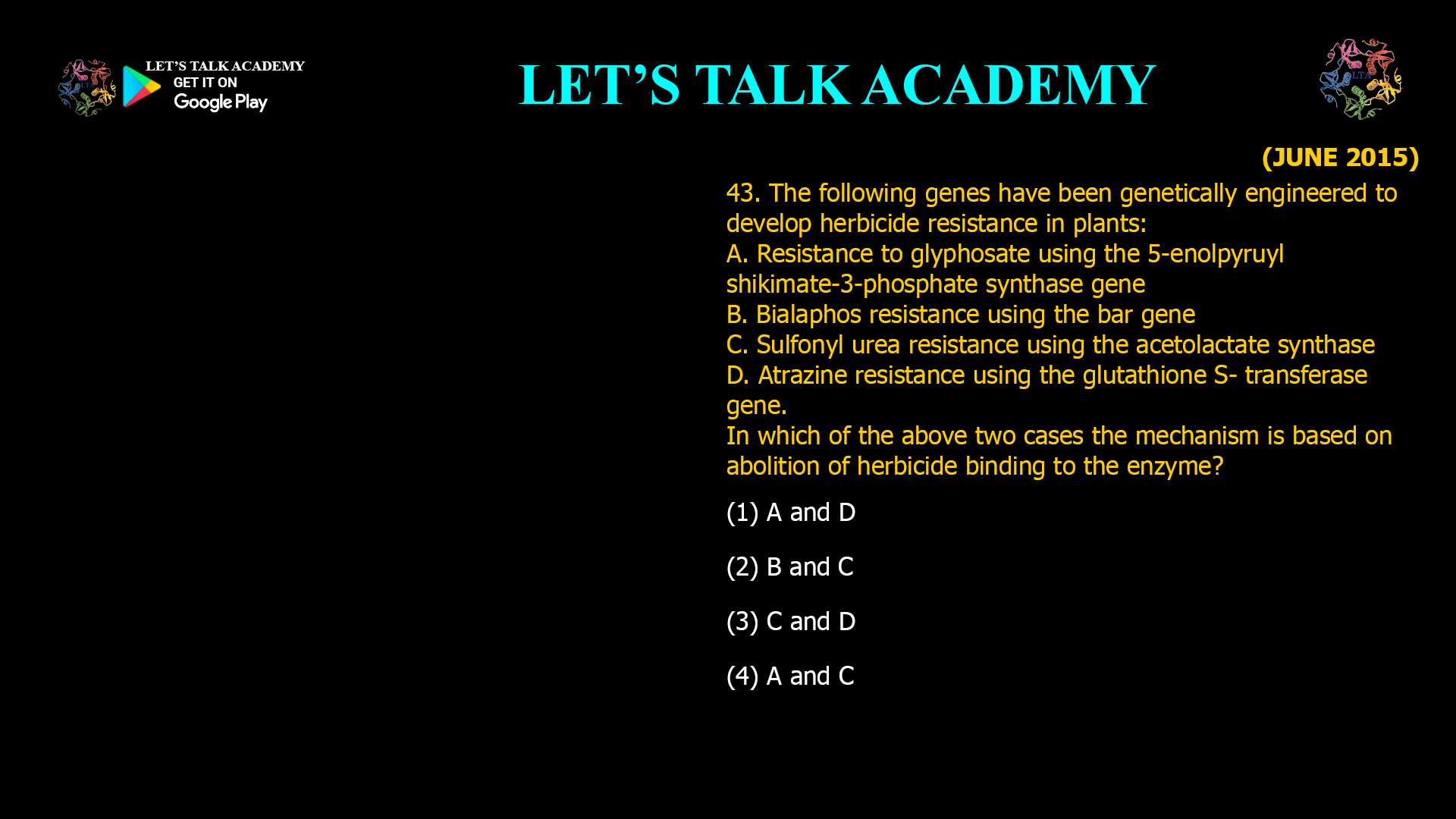- The following genes have been genetically engineered to develop herbicide resistance in plants:
A. Resistance to glyphosate using the 5-enolpyruyl shikimate-3-phosphate synthase gene
B. Bialaphos resistance using the bar gene
C. Sulfonyl urea resistance using the acetolactate synthase
D. Atrazine resistance using the glutathione S- transferase gene.
In which of the above two cases the mechanism is based on abolition of herbicide binding to the enzyme?
(1) A and D (2) B and C
(3) C and D (4) A and C
The mechanism based on abolition (loss) of herbicide binding to the target enzyme operates in cases A and C, so the correct answer is (4) A and C.
Explanation of each gene/option
A. Resistance to glyphosate using the EPSPS gene – target-site mechanism
-
Glyphosate targets the chloroplast enzyme EPSPS (5‑enolpyruvyl shikimate‑3‑phosphate synthase) in the shikimate pathway for aromatic amino acid biosynthesis.
-
Engineered glyphosate‑tolerant crops often express a mutant or microbial EPSPS with reduced glyphosate affinity; this altered active site abolishes or greatly reduces herbicide binding while retaining catalytic activity.
-
Therefore A is a classic example of resistance via loss of herbicide binding to the enzyme.
B. Bialaphos resistance using the bar gene – detoxification mechanism
-
Bialaphos and phosphinothricin (glufosinate) inhibit glutamine synthetase, causing ammonia buildup and plant death.
-
The bar (or pat) gene encodes phosphinothricin acetyltransferase, which acetylates and detoxifies the herbicide molecule, leaving the native target enzyme unchanged.
-
This is metabolism-based resistance, not loss of herbicide binding, so B does NOT fit the asked mechanism.
C. Sulfonyl urea resistance using acetolactate synthase (ALS) – target-site mechanism
-
Sulfonylurea and related herbicides inhibit ALS (also called AHAS), blocking branched-chain amino acid biosynthesis.
-
Resistance is commonly conferred by point mutations in the ALS gene that change key amino acids in the active site, reducing or abolishing herbicide binding while maintaining enzyme function.
-
Thus C is another clear example of target-site (binding-site) based resistance.
D. Atrazine resistance using glutathione S-transferase (GST) – detoxification mechanism
-
Atrazine is a PSII inhibitor; natural and engineered resistance in crops such as maize often involves elevated GST activity that conjugates atrazine with glutathione, rapidly detoxifying the herbicide.
-
Here the herbicide is metabolized; the PSII target is not mutated specifically to prevent binding.
Why option (4) A and C is correct
-
Only A (EPSPS for glyphosate) and C (ALS for sulfonylureas) involve altered target enzymes with reduced herbicide binding.
-
B (bar) and D (GST) work by metabolic detoxification of bialaphos/phosphinothricin and atrazine, respectively, so they do not match the “abolition of herbicide binding” mechanism.
SEO-oriented introduction (for article use)
Herbicide-resistant crops can be engineered either by altering the herbicide’s target enzyme so that the herbicide no longer binds effectively, or by introducing detoxification enzymes that metabolize the herbicide. In the case of glyphosate (EPSPS) and sulfonylurea herbicides (ALS), resistance is achieved through mutations in EPSPS and acetolactate synthase that abolish or greatly reduce herbicide binding, making options A and C the correct pair for target-site resistance.



